Green building revenue jumped in 2022 with more projects seeking third-party sustainability certifications. Federal spending and new carbon-cutting standards helped advance climate-friendly design, but Top 100 Green Design and Contracting firms say greater isn’t always greener when it comes to environmental impact.
Market indicators are “completely misaligned with the climate crisis,” says Jim Nicolow, director of sustainability at Lord Aeck Sargent, ranked No. 80 on the green design list. “Subsidized fossil fuel energy indicates that renewable energy is a premium option, as if business as usual doesn’t pose an existential risk, and climate change is somehow an external cost.” Because “unhealthy building products are often the least expensive option,” their associated health risks are an “external cost,” he says. “Adam Smith’s invisible hand of the market does not work in the best interest of the public when costs are externalized.”
Related Links:
ENR 2023 Top 100 Green Buildings Design Firms
ENR 2023 Top 100 Green Building Contractors
View complete 2022 list, with full market analysis
(Subscription Required)
Design revenue in 2022 from U.S. projects registered as actively seeking third-party ratings group certification under sustainability standards increased 22.3%. International sustainable design revenue rose 31.9%, this year’s list shows, to $1.82 billion.
Revenue gains were not limited to the largest firms, with ENR’s Top 10 designers’ share of the total market falling to 53.7% this year from 55.6% on last year’s list. Median green design revenue is up 30.9% to $27.89 million, with 62.7% of firms on the 2023 list also reporting a previous increase.
Top 100 green contracting revenue tells a similar story. Overall, revenue rose 15.2%, with international contracting revenue up 17.5% to $3.5 billion. Median revenue increased 27.4% to $329.2 million for green contractors. About 67% of companies that reported revenue to ENR this year and last year noted a revenue increase on their 2023 survey.
All market sectors had a noticeable increase in 2022 green design revenue, except for industrial-manufacturing, which fell slightly. Longer term, the commercial office sector has seen a steady decrease in its design share since ENR started tracking its current set of 13 markets in 2020—falling to 17.4% in 2022 from 21.8% that year.
In contracting, green industrial-manufacturing and telecom markets saw the most revenue growth, up 50.6% and 43%, respectively, last year. Both markets have seen explosive growth over the past five years. Revenue for industrial-manufacturing has increased 457%, and is up 377% for telecom since 2018. In that timeframe, telecom market share has jumped from the third smallest (3.3%) to the second largest (11.4%).
Deep-rooted Challenges
Behind their growing percentages, Top 100 Green Design and Contracting firms say there is also a growing concern related to the construction industry’s embodied carbon, inflated project costs and sustainably navigating new delays in a complex supply chain.
The green building market is heating up to a point where CO₂ created in production and transportation of materials—in addition to building construction, maintenance and eventual demolition—exceeds the emissions associated with building operation, explains A. Brian Lomel, director of TLC Engineering’s PEAK Institute. The Orlando, Fla.-based firm is ranked No. 39 this year, from No. 70 previously.
“In other words, most of the carbon emissions associated with buildings are already in the atmosphere at day one, before the building even begins to operate,” he points out. Referencing new changes to U.S. General Services Administration standards for federal buildings, Lomel says ambitious efforts to cap embodied carbon in concrete, steel, glass and asphalt use will help generate “big change” in how the architecture-engineering-construction industry operates.
“Manufacturers will have to start tracking the data through [environmental product declarations], and contractors will have to document CO₂ emissions created in transportation of the materials to the jobsite, their onsite activity and demolition,” says Lomel. As teams coordinate design to yield lower emissions, he anticipates more building owners will need to report potential carbon output data to environmental tracking groups or investors.
“Although some A&E firms are part of the movement to lower embodied carbon in construction, many firms have yet to acquire the necessary knowledge to employ these skills,” he says.
Aquariums | By Jonathan Keller
Seattle Aquarium’s New Ocean Pavillion Targets Carbon Cut
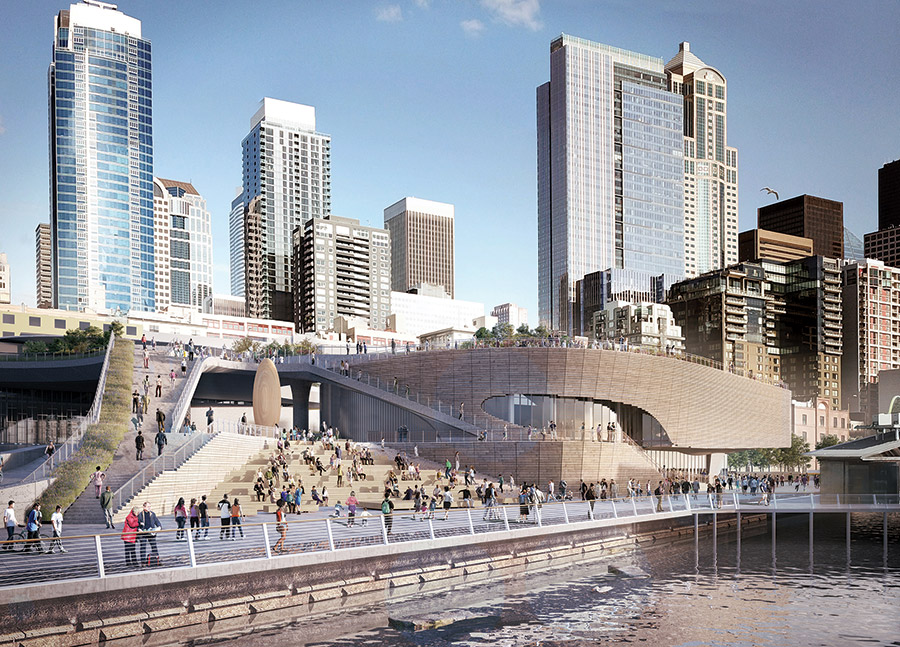
Image courtesy of LMN Architects
LMN Architects (No. 37) is providing planning, architecture and design services on the Seattle Aquarium’s new Ocean Pavilion. The building, with 50,000 sq ft of exhibition space, is designed to be all-electric and targets a 95% operational carbon reduction compared to similarly-sized aquariums. It will also filter and recycle 96% of its seawater. The project team is seeking both Living Building Challenge Petal Certification for energy, water, beauty, equity and place, and LEED Gold certification—the latter a requirement for all city-owned buildings.
Tracking Embodied Carbon
Carbon emissions tied to raw material extraction often go unaccounted in lifecycle analyses of buildings due to a lack of data, explains Myrrh Caplan, vice president of sustainability at Skanska USA Building.
“Complicating the process is the high cost of conducting far-reaching valuations and audits,” she says. With this challenge in mind, Skanska and the Carbon Leadership Forum developed in 2019 an Embodied Carbon in Construction Calculator to track it in building materials. The tool was made open-source, Caplan says, to “democratize data and provide transparency as companies and governments aim to achieve their carbon reduction goals.”

“There are real solutions available today that are not yet integrated into standard practice across disciplines and trades.”
Paula Zimin, Arup Climate, Sustainability Leader
Hord Coplan Macht sustainability manager Ilijana Soldan believes embodied carbon is construction’s “biggest challenge in the near term” due to the level of interdisciplinary collaboration required to address it.
“Not only does it require additional research and analyses during design phases, she notes, but also the need to have “an effective conversation to reduce embodied carbon that can’t be had without directly challenging decades-long, well-established construction norms.” Soldan adds: “Understanding how to lower embodied carbon impact will require extremely integrated teams moving forward, with everyone at the table willing to embrace innovation and change.” Adding to the challenge is a lack of industry-wide understanding, training and funding to build awareness, says Paula Zimin, senior climate and sustainability leader at Arup.
“There are real solutions available today that are not yet integrated into standard practice across disciplines and trades, which could help make decarbonization of new construction and major renovations more effective,” she says. Cutting the industry’s carbon footprint beyond new construction will require “all parts of the value chain to work together for standardization of certifications, evaluation of procurement paths and compliance regulations,” Zimin adds.
Absent close collaboration, it can be difficult for all project partners to fully understand sustainability goals and true costs, says Emily Tilgner, McCownGordon vice president of building performance solutions. The Kansas City-based contracting firm is ranked No. 83.
“We sometimes see design teams underestimate the initial cost and overestimate the value or anticipated result,” she explains. “On the other hand, construction managers often overestimate initial costs and underestimate the true value.”

“We sometimes forget that we must be working on many different solutions simultaneously: water, emissions, health, equity and more.”
Chris Hellstern, Living Bldg. Director, Miller Hull
At LMN Architects, principal Kjell Anderson says cost inflation over the last few years has challenged “nearly all” firm projects to meet minimum program budgetary requirements. “Sustainability strategies have demonstrated paybacks in terms of health and utility bills” when the building is operational, he says. “But difficult conversations around sustainability goals and immediate costs sometimes result in lower long-term aspirations.”
To maintain project sustainability goals, the strategy of ZGF Architects has been to holistically calculate project budgets “instead of relying on simple paybacks that don’t fully account for the cost of pollution, and often result in sustainability ideas being removed from projects,” says principal Arathi Gowda. “Of course, this approach to designing sustainably is not achieved in a vacuum.”
If the AEC industry is to keep pace with project goals, pursue third-party certifications and reduce building environmental impacts, the adoption of sustainable building practices must be a jog and not a sprint, explains Chris Hellstern, Living Building Challenge Services director at Miller Hull Partnership. “We sometimes forget that we must be working on many different solutions simultaneously: water, emissions, health, equity and more,” he says. “Often, these areas are not in conflict with each other but instead have many synergies.”
Mixed-use | By Jonathan Keller
Mithun-Designed NC Innovation Campus Targets Listing
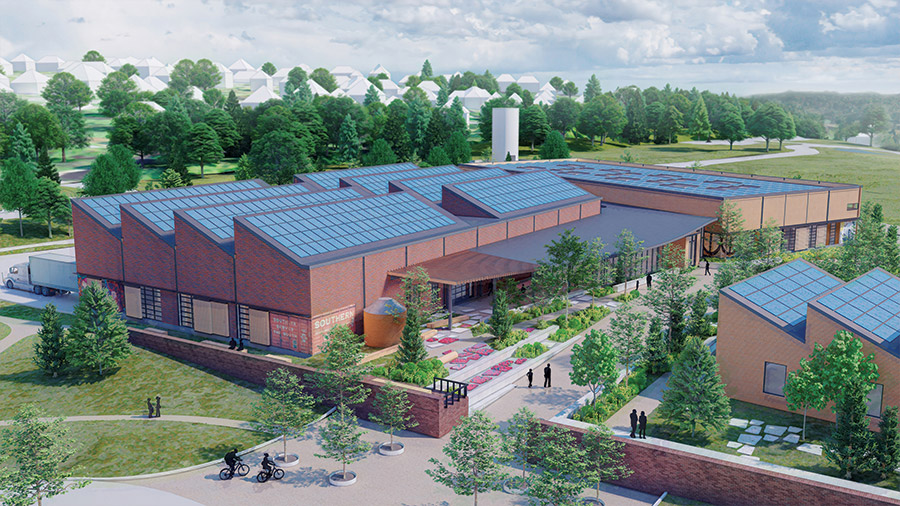
Image courtesy Mithun
Non-profit group the Industrial Commons is redeveloping a 27-acre brownfield site in Morganton, N.C., northwest of Charlotte, into the Innovation Campus, a mixed-use space that features worker-owned, small-scale manufacturing and skilled traning facilities. Mithun (No. 62) is lead architect on the project, which will target full Living Certification under the Living Building Challenge for net-positive outcomes, the firm says. Site cleanup work is due to begin this winter, with groundbreaking scheduled for early 2024.
Boosting Performance
Dattner Architects uses a series of metrics called “passive house” to justify higher costs of better performing buildings. “This is a series of measures based on building science that dramatically reduces a building’s energy usage or operational carbon, but there are modest premiums both on the hard cost and soft cost side of a project’s development budget,” the firm says. “For public agency clients that are accustomed to helping establish forward-looking policy, this is less of an issue. For private clients that are more focused on the bottom line and don’t see the marketability of better performing and healthier buildings, it’s a more difficult case to make.”

“Resilient systems and communities can withstand and thrive in a changing environment, which is more essential now than ever before.”
Margaret Montgomery, Principal, NBBJ
Sustainability and occupant well-being are no longer “nice-to-haves” for NBBJ clients, according to sustainability leader Margaret Montgomery. LEED and other sustainability certifications have become an integral part of long-term principles and values for them, she adds.
But amid inflation and supply chain disruptions, WDG Architecture’s Esther Christian says more owners are looking to provide Fitwel or WELL certifications because they are at times less costly to achieve than LEED or Green Globes.
“Although these rating systems are positive, they do not aggressively address energy use of buildings,” she says. In some cases, balancing cost and operability can mean complementing complex solutions such as thermal energy harvesting and carbon-neutral buildings with more cost-effective materials, such as composite instead of aluminum windows, the integration of green space and access to daylight.
For Trees Atlanta’s new headquarters, Lord Aeck Sargent began planning for a low-embodied-carbon mass timber structure, but high costs and materials availability challenges drove a change to a lower cost but higher-embodied-carbon steel structure, explains Joshua Gassman, the firm’s sustainable design director.
When COVID-19 disrupted the structural steel supply chain, the design team pivoted to a Type V wood framing.“Conventional wood framing ultimately best met the project’s cost and schedule limitations as well as embodied carbon goals,” he explains.
Air testing prior to occupancy has also become more common, says Isaiah Walston, sustainability director at HITT Contracting. “Additional specifications and review of materials’ ingredient lists to confirm potential health impacts have also become more prevalent,” he says. Sustainable rating systems are meant to push the market, but major revisions can also dramatically slow down adoption, he explains.
“It’s a fine line of pushing too far and not gaining adoption versus waiting too long to revise standards, which stagnate the market,” says Walston. “Working in an ever-changing industry that is always moving the goalpost can be challenging, but it’s also rewarding.”
Natural Synergies
Designing buildings as living systems and for resilience can create natural synergies with features that work with environmental factors instead of against them, NBBJ’s Montgomery adds. “Resilient systems and communities can withstand and thrive in a changing environment, which is more essential now than ever before,” she says. “This requires thinking across scales and perspectives at how buildings, streets, landscapes and bodies of water can support and enhance naturally resilient systems.”

“Integrating emerging technologies could help make sustainable building standards more effective.”
Jennifer Taranto, vice president of sustainability, STO Building Group
Mark Adams, SmithGroup vice president and national workplace director, says he has also noticed a shift—with more owners emphasizing spaces that promote physical health, such as ergonomic furniture, adjustable sit-stand desks, on-site gyms or fitness zones. The Detroit design firm ranks No. 18 this year.
“This reflects a growing post-COVID awareness of the significant impact the work environment has on employee well-being, productivity, and job satisfaction,” he says.
Webcor sustainability director Sarah Rege says recent wildfires in California have reignited a focus on indoor air quality in addition to WELL and Fitwel certifications.
To address changing regional building needs, LEED requirements and similar building standards “must continuously evolve to stay relevant and effective,” says STO Building Group’s Jennifer Taranto, vice president of sustainability.
“This evolution needs more focus on embodied carbon, circular design principles and post-occupancy performance monitoring,” she says. “Integrating emerging technologies, like advanced sensors for real-time energy optimization, could help make sustainable building standards more effective, meet municipal energy and carbon disclosure requirements and keep buildings performing as efficiently as possible.”
For the past several years, Dewberry says it has been using “3D modeling and research-based analysis tools to guide design decisions.”
In addition, “we are hearing clients request nature-based design solutions, as research shows tremendous positive effects on human physical health, mental wellness, and resilience,” says Jenni Betancourt, sustainability director for the No. 73-ranked design and engineering firm. “Our clients affirm that the biodiversity and biophilic aspects of interior and exterior designs they occupy enrich the daily users and visitors of the spaces.”
At Shawmut Design and Construction, clients are increasingly requiring that projects be designed for Red List compliance, says sustainability manager Elizabeth Murphy—“or establish aspirational goals for incorporating Red List compliant materials to the greatest extent possible.” Certified through the International Living Future Institute, Murphy explains that the contains more than 20 classes of chemicals with more than 800 ingredients that are harmful to human health and the environment. The documentation and level of effort required for certification by the Living Building Challenge as part of the Materials Petal can be challenging for project teams to achieve without proper planning and proactive coordination, she says.
“There are also limitations where certain manufacturers are not yet prepared to meet the ingredient restrictions or are not willing to share proprietary information,” she adds. Regardless, owners are placing a greater importance on human health throughout the entire material life cycle, which is a “positive direction for the industry,” Murphy says.
Healthcare | By Jonathan Keller
NBBJ Targets Inclusive Healing
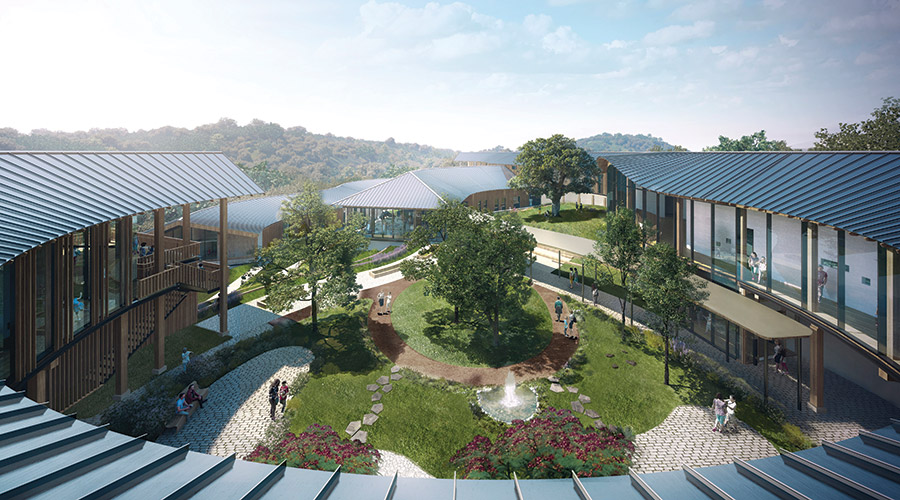
Image courtesy of NBBJ
NBBJ (No. 22) provided planning and design services on the Montage Health Ohana Center in Monterey, Calif. The children’s mental health facility’s design incorporates research from molecular biologist Dr. John Medina, and features extensive use of cross-laminated timber.
Cultivating Green Skills
When it comes to overall occupancy health and building performance, Susan Heinking, Pepper Construction senior vice president of high performance and sustainable construction, emphasizes the need for data models based on future weather predictions and not previous patterns.
“This is one of our biggest challenges, but it can actually be an opportunity—risk mitigation through designing and building based on future climate trends and changes rather than past climate patterns,” she says. “By studying the changes we are experiencing today, we can help better predict future weather patterns, allowing us to update building codes that are better suited for future climate models and construction of more resilient structures.” This will allow firms to develop employee skills needed to address such challenges, she explains.
“It’s not a perfect science and predicted data will never be 100% reliable, but by collaborating and having open, informed conversations, we can better prepare for what buildings in different regions will experience in the years to come and need to sustain high performance standards,” she adds.
As performance, technology, comfort, wellness and other sustainability standards and codes increase the complexity of buildings, the trends underscore the construction sector need for skilled workers, says Kate Bubriski, director of sustainability and building performance at Arrowstreet. “This requires workforce development both for those already in the industry and those who are studying to join the field,” she explains.
At rand*, the company undertakes a variety of measures to educate employees in sustainability, including reimbursement on LEED accreditation costs, according to sustainability coordinator Tricia Matyas.
She explains that company teams take a “hands-on approach” when it comes to sustainability projects. “Using educational meetings and check-ins, our employees are guided through the process of how to support sustainable projects through procurement and internal tracking of green materials, waste diversion best practices and operating healthy construction sites.”
PCL has also been active to ensure employees have a design and construction-oriented green thumb. A network of sustainable construction advisors serves as experts in their local offices, explains Andrew Ahrendt, the firm’s director of integrated construction services. “Part of their role includes supporting sustainable projects no matter the sustainability goal—whether it’s waste management, low-volatile organic compounds materials, low-carbon or all of the above,” he says.
“Having a core understanding of sustainable practices, materials and technology will be important to our industry overall moving forward,” says Richard McDonald, Sundt Construction sustainability director.
In their response to growing sustainability demands, firms must prioritize what is the best climate-friendly design—not just add complexity, says Consigli Construction’s Steven Burke.
“There can be a tendency when making revisions to green building programs to layer in increasing levels of complexity that is justified ostensibly as increased stringency,” he says. “The goal should always be to increase performance levels and decrease complexity. We should be using language and creating goals that are accessible to anyone—not just sustainability professionals—whenever possible.”
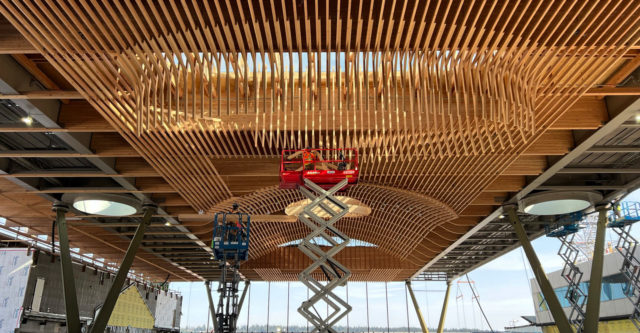





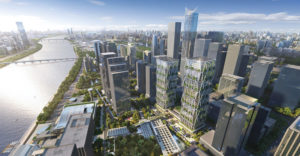
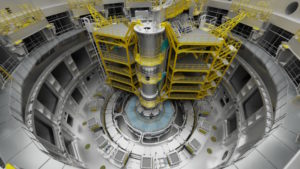

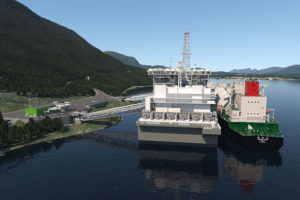



Post a comment to this article
Report Abusive Comment